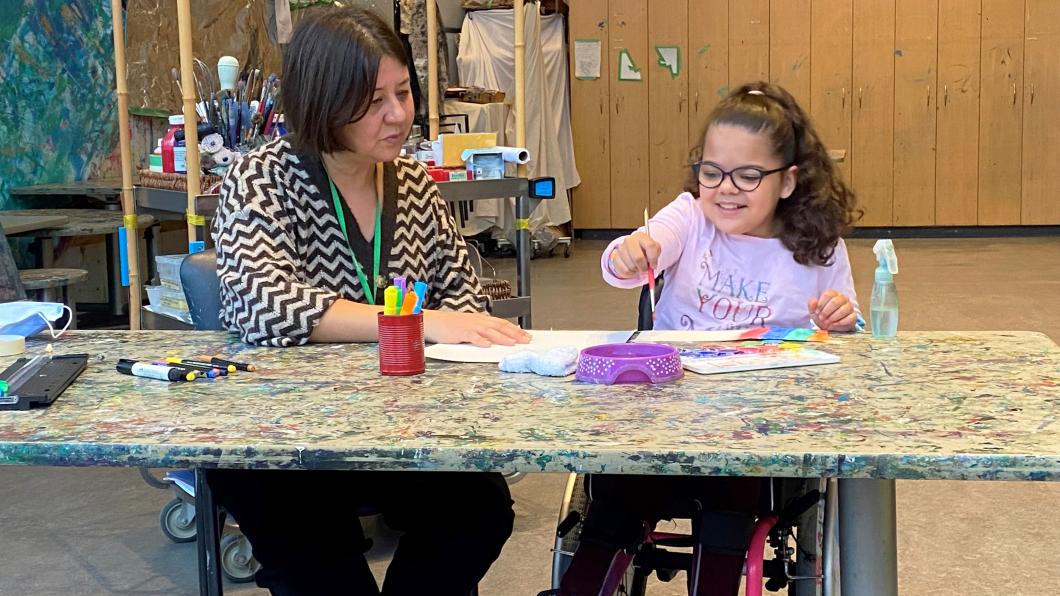
Artist gives hospitalized kids a sense of agency
By Louise Kinross
Shannon Crossman recently chilled some fresh snow, then melted it into water so an inpatient child could use it to mix watercolour paints. “I wanted to include the season, so I told them we’ve captured some of winter into our painting.”
Shannon has been working as an artist at Holland Bloorview for 30 years. She now splits her time between coordinating the Music and Arts program at the hospital and clinical work with children doing rehab here and their parents.
You may have noticed Shannon with her mobile art cart filled with paint, clay, fabric, beads, wood and all of the tools that allow kids to create projects at the bedside.
“The work we do is meant for choice and agency and to alleviate boredom and loneliness,” she says. “It’s a chance for them to be themselves, and see themselves as whole people doing things that are comforting and meaningful and familiar to them. One child said ‘I really like it because you don’t ask how crappy my meds are making me feel.’ I’m not probing about their injury or surgery unless they talk about it. They’re driving the conversation and experience. This is creating some normalcy for them when they don’t have choice in interventions like physiotherapy, which is sometimes painful.”
Art at Holland Bloorview is less about instruction and more about “exploration and expression,” Shannon says. Each child chooses what they do from a range of options, as opposed to being presented with an activity. “We try to set things up so we can say ‘yes’ instead of ‘no.’ If an activity is messy it’s done in an environment to get messy.”
Activities are adapted for children with disabilities. For example, “we have a power link that allows us to connect a jelly bean switch to a sewing machine. The buttons on the actual machine can be hard to push. This way “a child can drive the machine on and off while I feed the fabric through.”
Many children find art-making soothing. “When I ask what they think the benefit of art is, they’ll say ‘it will help me not to be anxious.’ If I ask what would they like to feel, instead of anxious, they’ll say ‘I’d like to feel calm.’
Shannon says the greatest challenge of her work is the wait list. “When I tell kids this is once a week they’ll say ‘Can I have it every day?’ Knowing that they want the intervention and seeing how much they enjoy it makes me want to give them more of it. For me, as a practitioner, I excel in that one-to-one.”
Shannon says the main emotion she experiences at work is satisfaction. “When kids get to a place where they’re feeling good there’s a sense of peace and accomplishment.”
She does feel sad when hearing parents share painful stories during the art workshops she offers caregivers. “Sometimes the simplest of questions will lead to a floodgate of feelings. I might say ‘You’re painting a landscape?’ and they’ll say ‘I haven’t been to the beach since before my child’s accident.’ Some curiosity might open a whole discussion about the child’s injury and rehab and how deeply they love their child and how deeply they want them to heal. I tend to see the kids as pretty resilient, but I really feel for the parents.”
Shannon says she copes with stress by reaching out to colleagues. “The main thing that helps me is talking. If something has happened, I’ll get up and find someone I know and trust here to talk to.”
She likes to draw and journal in the morning before work “when my mind is super fresh and rich ideas and creative solutions pop into my head.”
If she could change one thing about the group art programs we offer outpatients it would be making “the fee-for-service cheaper or free, or subsidizing it in a way that anyone who needed to come could come. For example, we know that single mothers who are racialized and English isn’t their first language have less access to resources for their child.”
Shannon says she identified herself as an artist at the age of four, and it was the influence of her parents that led her into the field. “My dad was a social worker and developed programs in the community and I was exposed to a lot of ways of interacting with a wide range of people. My mom used to work at the 4-H club in the states, and she also worked at what used to be called a sheltered workshop [for people with disabilities.] I’ve always found it delightful to work with children. They’re emerging into their sense of who they are and they’re unfiltered in the most charming way. It’s meaningful to be part of that.”
Like this content? Sign up for our monthly BLOOM e-letter. Visit us at BLOOM Facebook, follow @LouiseKinross on Twitter, or watch our A Family Like Mine video series.